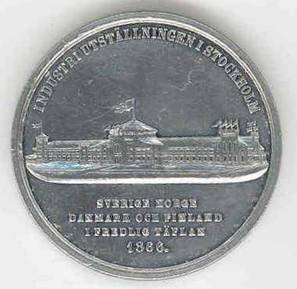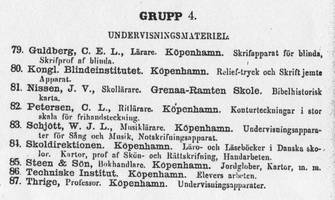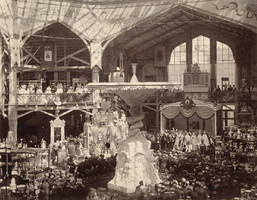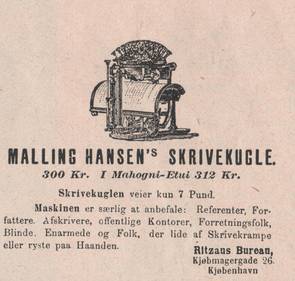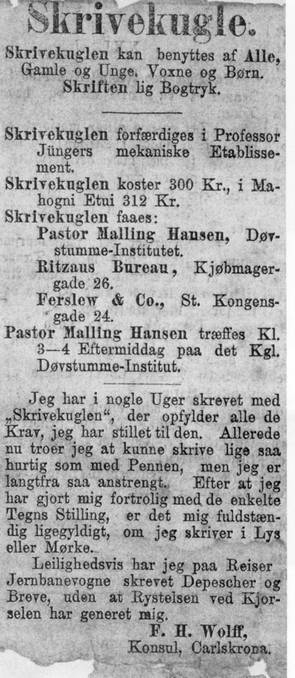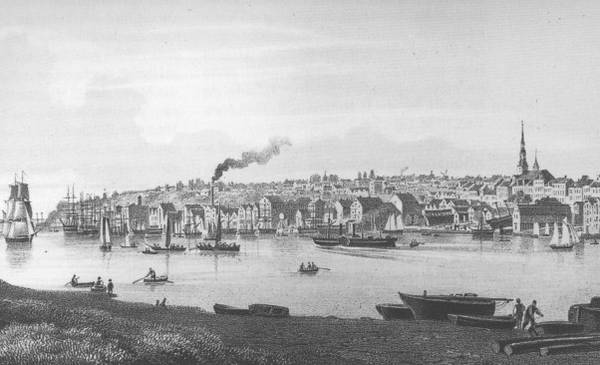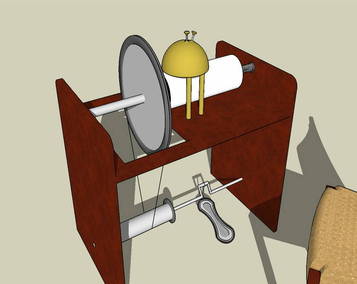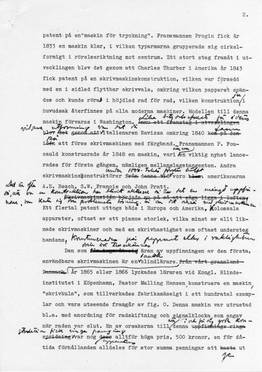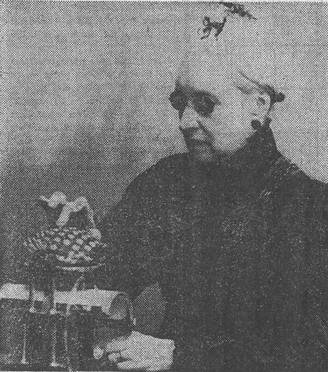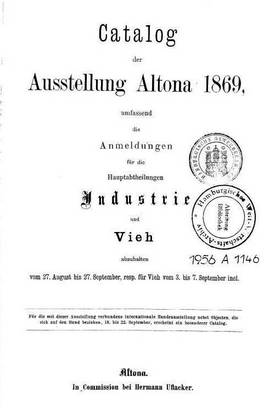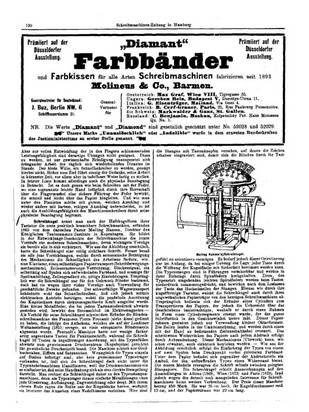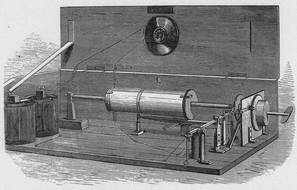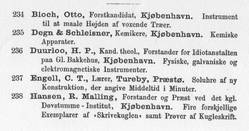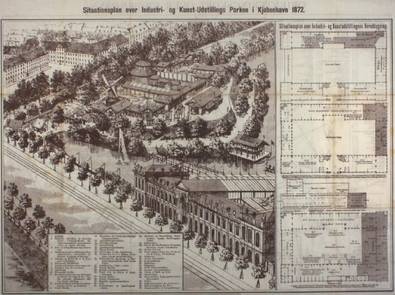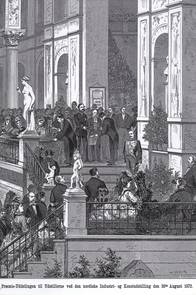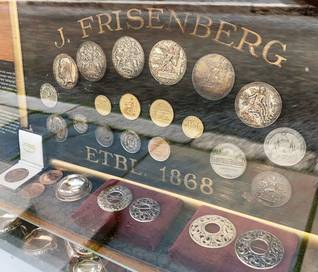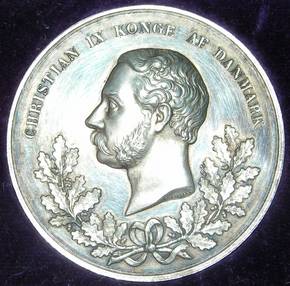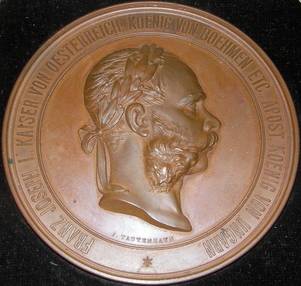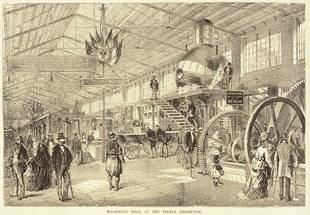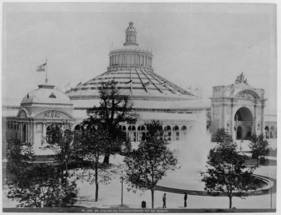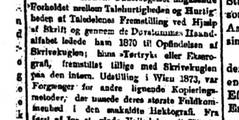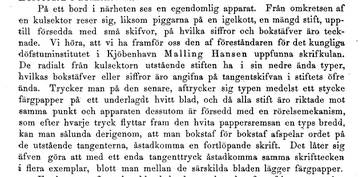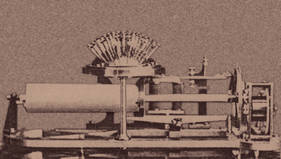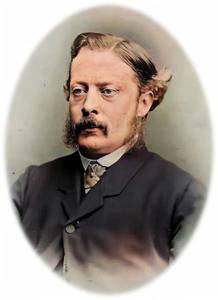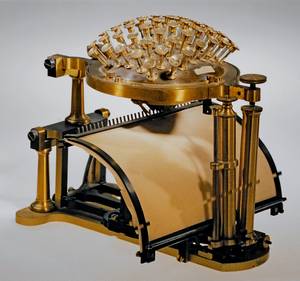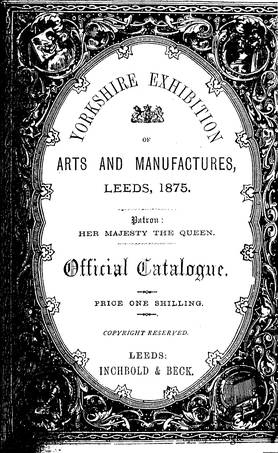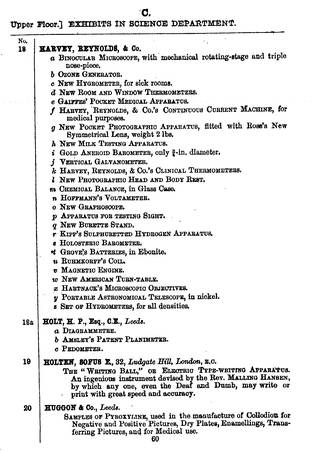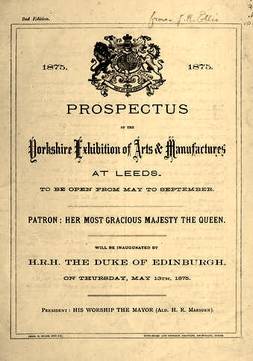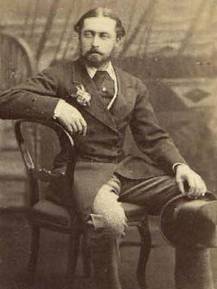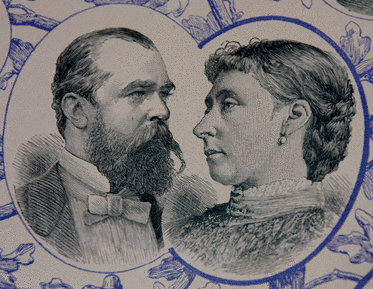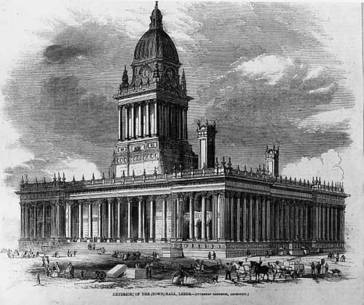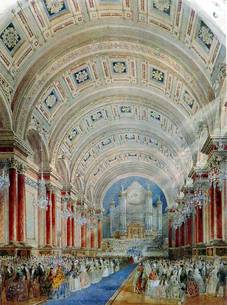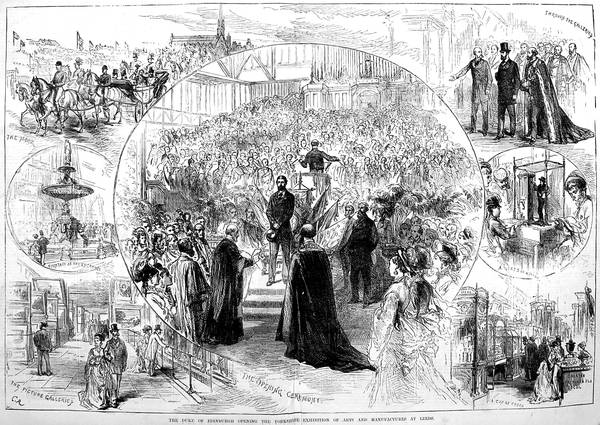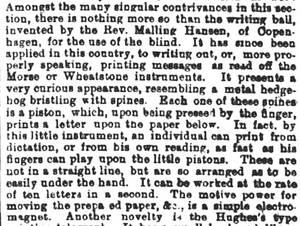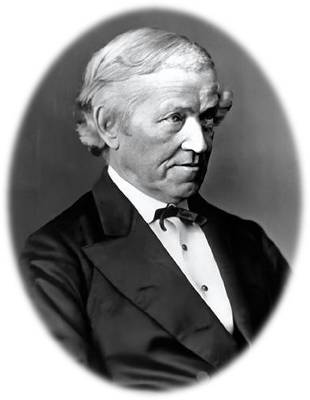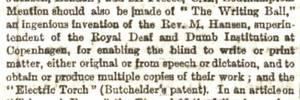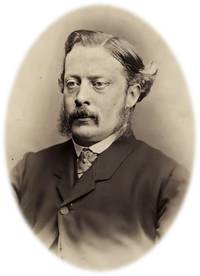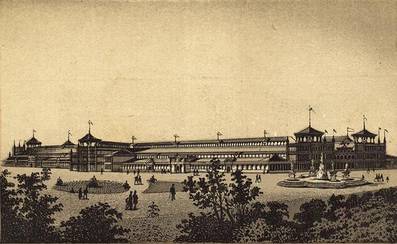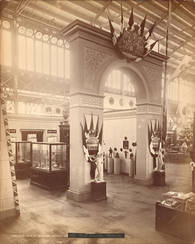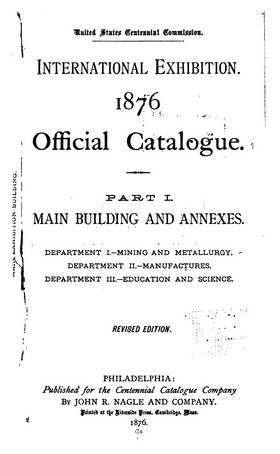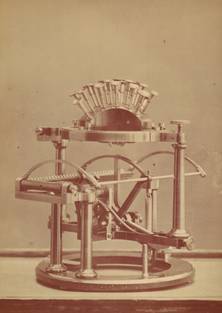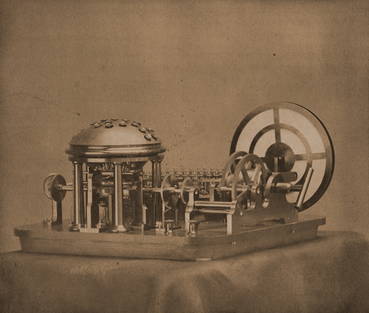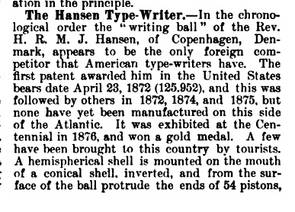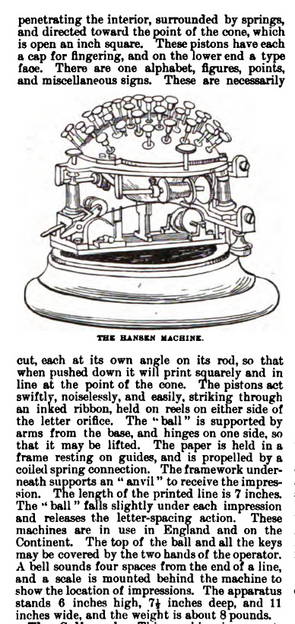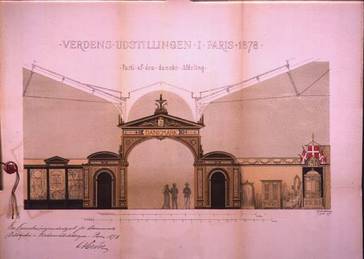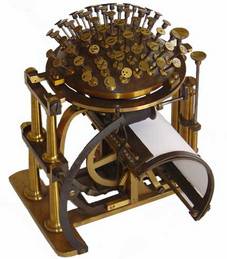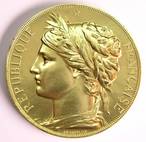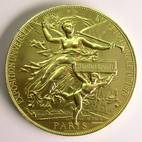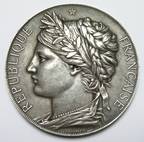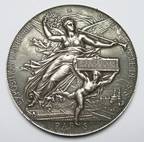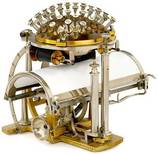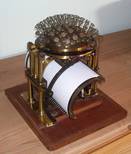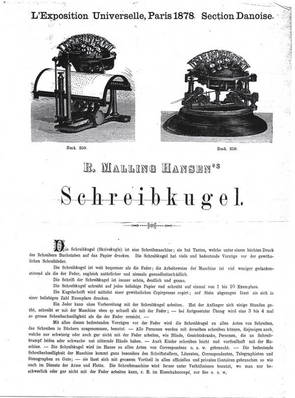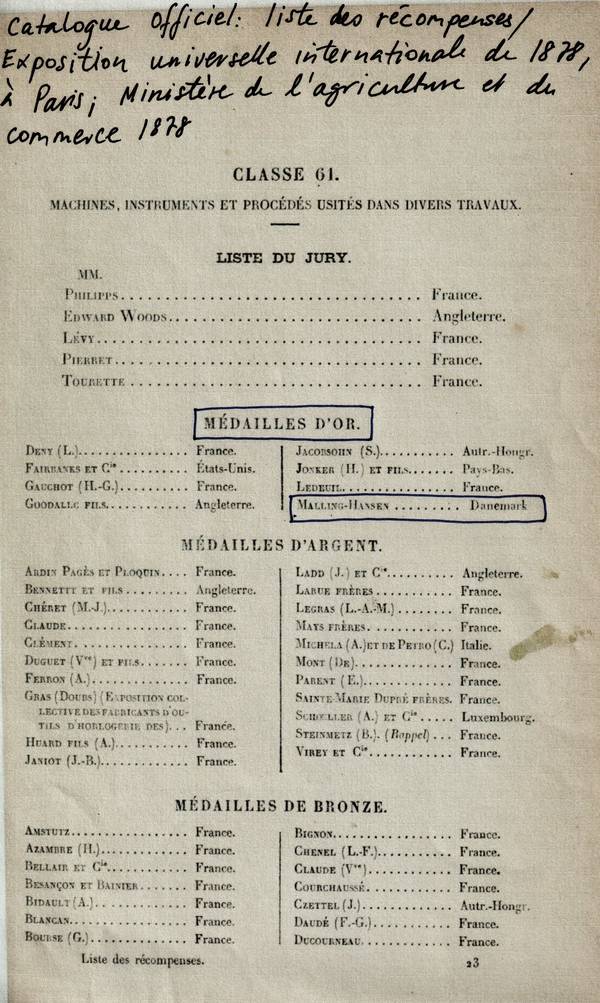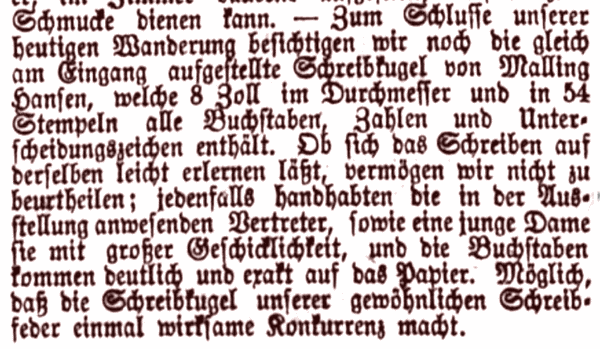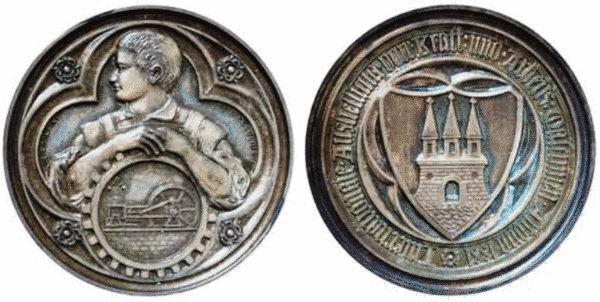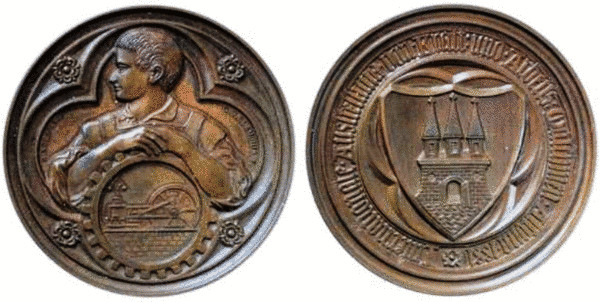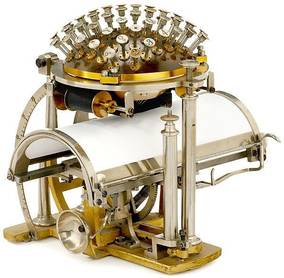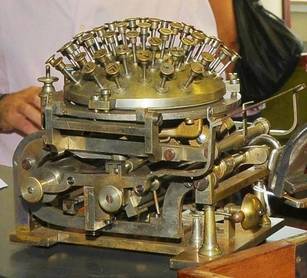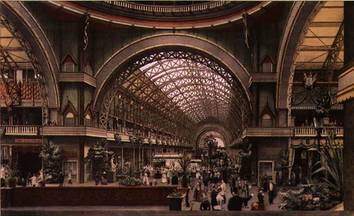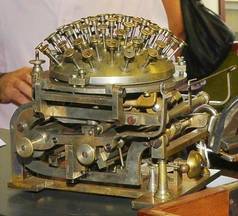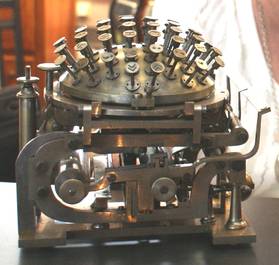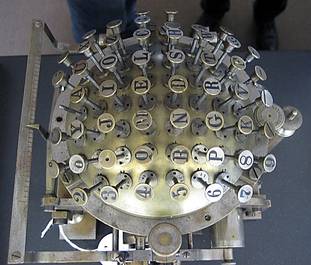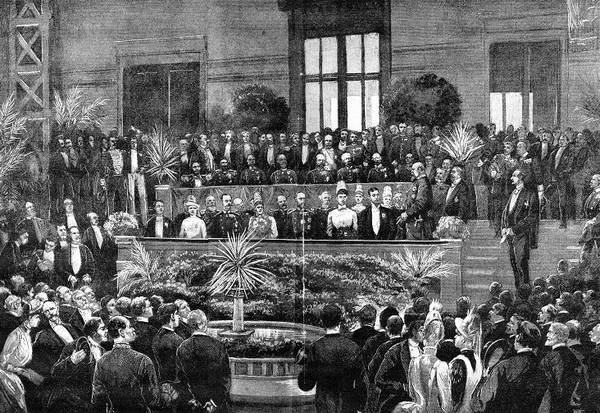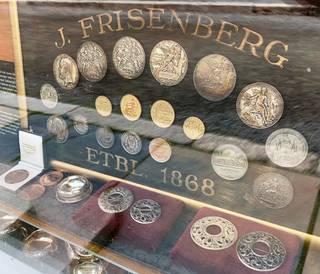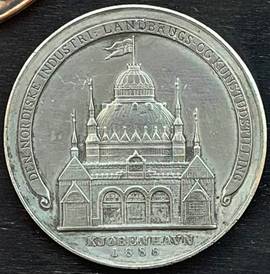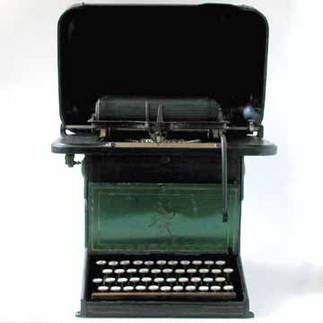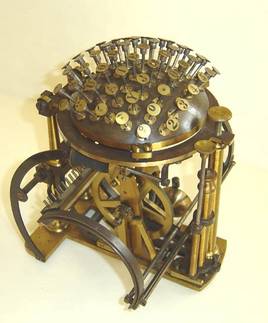The Exhibitions.
The Writing Ball's successful tour through Europe and USA
Was the writing ball exhibited in Stockholm 1866 and Altona 1869?
During the past year, new and hitherto unknown information about Malling-Hansen’s participation at some of the early industrial expositions has been discovered both from German, Swedish and Danish sources. It is claimed in the old articles, that the writing ball was exhibited at the Industrial Exhibitions in both Stockholm in 1866 and Altona in 1869. If this is correct, we will have to reconsider everything that has been known up until now concerning when the first writing ball was constructed. We know for a fact that Malling-Hansen started to experiment with the placements of the letters on a porcelain ball in 1865! And he probably worked contiously throughout the late 1860's to develope a prototype. I have my doubts that a machine was finished already in 1866, but that a model was ready in 1869, and probably even earlier, I am quite sure of. In his first patent application from january 1870 RMH wrote:
"With these investigations as a basic, I started to build an apparatus for fast speed writing, and this apparatus eventually developed to be the one that I have tried to show in the achieved drawings, and that I will eventually try to describe."
Evidently RMH had the first writing ball ready when he wrote the patent application, and considering the time it will take to make the rather complicated text and the drawings in the patent application, the first model must have been finished at the latest in 1869.
Stockholm - 1866
In an undated and anonymous article from the archive of the Technical Museum in Stockholm the author suggests, that the writing ball might have been exhibited in the Industrial Exhibition in Stockholm in 1866. To support this claim he points out, that the official catalogue of the exhibition, in Group 4, Teaching material, shows, that two writing apparatuses were displayed: No. 79, a writing apparatus for blind people constructed by C. E. L. Guldberg from Copenhagen and No. 80, imprints, writing samples and writing apparatus exhibited by the Royal Institution for the Blind in Copenhagen. In the author’s opinion it is the specimen No 80 that may have been an early model of the writing ball. There seems to be a widespread apprehension that Malling-Hansen’s aim was to make a remedy for blind people when he constructed his writing ball, and in the anonymous article from Sweden it is wrongly stated that Malling-Hansen was a teacher at the Royal Institution for the Blind. That is probably why the author draws the conclusion that the exhibition object No. 80, a writing apparatus from The Institution for the Blind, might have been a writing ball. Malling-Hansen never worked as a teacher there! And in spite of the fact that the Institution for the Blind is situated very close to the Institution for the Deaf-mutes, where Malling-Hansen worked as a teacher and principal, nothing can be found in Malling-Hansen’s own writings about his invention to support the idea, that the writing ball was made to help blind people. On the contrary – Malling-Hansen always claimed that his machine was made to be a fast speed writing machine, and that it was his observations of the deaf children using sign language, “speaking with their hands”, that convinced him, that it would be possible to write letters on a machine as fast as the children could form letters with their hands. In the sign language of that time, each letter of the alphabet had its own sign. He was also inspired by the thought of a pianist playing on a piano keyboard at an extremely high speed – pressing down each key at a much higher speed than anyone was able to write a letter with pen and ink. But he never mentioned in his writings that he was inspired by blind people, and it is difficult to be sure of where this idea came from.
It could possibly have to do with the fact, that the very first attempts to make writing machines by others, were motivated by the wish to help blind people. And even though this was not the case with Malling-Hansen, it may have been reasonable to assume this, if the journalist was not well informed, and when it was first written down somewhere, a “fact” that was only a false assumption, could easily be repeated in other publications. In some presentations in magazines and newspapers from the early 1870’s it is mentioned, that the writing ball would be of tremendous help for blind people, but this was not the words of Malling-Hansen himself, it was the article writers own evaluation. It must also be admitted that Malling-Hansen in some of his advertisements for his writing ball listed blind people as one of the category of users that would have great benefit from using a writing ball, but only as one of several different groups of potential users. And Malling-Hansen did make writing balls specially designed for blind people - but at a much later time. At the Paris-Exebition in 1878 he received both a gold medal for the writing ball as a writing apparatus, and a silver medal for the writing ball as an educational apparatus for blind people. It is known that Malling-hansen participated with four machines in Paris, one small model for paper strips, one "standard" specimen of the tall model with colour ribbon - and possibly one or two writing ball with the braille or moon alphabet on the keys instead of the ordinary letters.
Altona - 1869
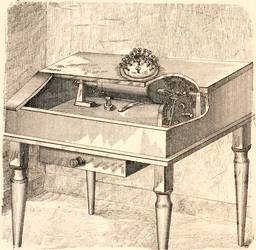
- An early writing ball-model, shown on an old American poster in a series of posters called "The growth of Industrial Art" by Butterworth, 1888. It is not possible to know for sure if this is just a box-model placed on a table, or if the ball is actually integerated in the table. There are no batteries inside, but one can clearly see a key connected to a spring mecanism.
It is far more difficult to form a strong opinion about the probability that the writing ball was exhibited at the International Exhibition in Altona in 1869. The most secure evidence would of course be if Malling-Hansen’s invention was listed in the official catalogue of the exhibition. This is not the case, unfortunately. There is no mentioning of typing machines whatsoever in the official catalogue. One could of course claim that this is a “waterproof” evidence that the ball was not exhibited, but one has to keep in mind that the catalogues of these early industrial exhibitions were in no way complete – some participants were listed but did not turn up, and other participants turned up, that were not listed. So it is still a possibility that Malling-Hansen went to Altona in person and presented his invention to the German audience.
But it has not yet been possible to find detailed information to confirm this. Although it is mentioned in several articles that the writing ball was exhibited in Altona, none of them contain further information about the writing ball model in question or about the circumstances around the event. But there is no doubt that a ready made writing ball actually existed in 1869. RMH started to work on his invention already in 1865, and we must assume that he continously worked to create a model throughout the late 1860's. Everybody who has tried to transform an idea into a product, knows how long time it takes to develope a prototype. And RMH probably worked out two different prototypes, one where the paper was fastened to a frame that was moved by hand, and one table-model, where the paper was attached to a sylinder, that worked by the means of a pedal. Any of these two models may have been exhibited in Altona.
Johanne Agerskov in her leaflet “Who is the Inventor of the Writing Ball” (Copenhagen 1925; in Danish), page 31, explains as follows: The German magazine “Zeitschrift für Büro-Bedarf” had an article about the writing ball with the information that the writing ball had been exhibited at the “Allgemeine Industrie-Austellung” in Altona in 1869. The Author, Mr J. Burghagen, had this information from a book entitled “Die Schreibmaschine”, published by Mr Otto Burghagen, the founder of “Bürobedarf”. He added that “Bürobedarf” no 76 of October 15, 1904 had a comment on the writing ball and stated the year of the invention as 1865. Mr J.Burghagen, however, had checked the exhibition lists from Altona 1869 and found that the writing ball was not included. Furthermore, Engelke Wiberg in a letter to Prof Hannover of 26 May 1924, comments concerning the information about Altona 1869: “It is likely that a friend of my father’s (I don’t recall his name) showed the writing ball in Hamburg at a company called “Donner & Co” in 1869 to representatives of the newspapers and magazines, and this demonstration was possibly related to the Altona exhibition; but since the patents were acquired only later, the idea of partaking in the exhibition was abandoned”.
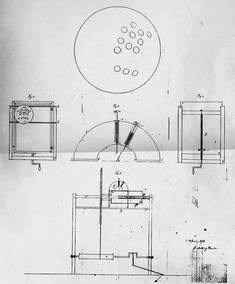
- If RMH exhibited a writing ball in Altona 1869, it must have been one of the two models on the first patent drawing from january 1870. In the patent application from early 1870 RMH writes that he had built the writing ball that was described in the application text, and the first model was certainly finished in 1869, probably even earlier.
Malling-Hansen was probably well known in the Altona area, as he had worked for 3 years as a teacher and headmaster at the Institution for the Deaf-mutes in Schleswig, when Altona, which today is a suburb of Hamburg, was a large city belonging to Denmark. Malling-Hansen also later made trips to visit institutions all over Europe and on holidays, so it would be no surprise if he also travelled to Altona in 1869.
And there is a way that we can find out for sure, whether Malling-Hansen really went to Germany in 1869, and the information can very well be hidden in the archives of Danish industrial funds, which donated financial support to Danish constructors to travel abroad. Further investigations in the archives of these funds can give us more secure evidence about Malling-Hansen and the Altona-Exhibition in 1869. It has been claimed that Malling-Hansen at some point received financial means from the “Reiersenske reisefond” but this information has not yet been confirmed.
Until certain evidence can be found, we are left to value the reliabillity of the different articles that claims that the writing ball was exhibited in Altona. Personally I am certain that there existed at least one prototype of the writing ball in 1869, and I will not shut out the possibillity that it was exhibited by RMH in Altona, either at the official exhibition or to the press and visitors at a private event.
Oslo, 09.09.08
Sverre Avnskog
London - 1871
For a long periode of time it has been the general view that the first time the writing ball was exhibited, was at the large Art and Industry Exhibition in Copenhagen in 1872. Just recently it was discovered through an article in the German periodical, Annalen der Typographie from 1871, that the writing ball actually had been displayed on what is often refered to as the South Kensington Exposition in 1871. The British arranged annual world exhibitions during the years 1871-1874, but unforunately it has not been easy to find information about these events. The Art Journal published large articles wich contained evaluations and extremely beautiful illustrations of many of the objects at the Exhibitions in 1871 and 1872, but unfortunately only the art work were presented, and an official catalogue of the event has not been possible to find yet. But in a letter from the spring of 1871 Malling-Hansen writes that he is planning a travel abroad very soon.
We know for sure that the first of them took place from May to September 1871. There were illustrated articles in the London Illustrated about the Exhibition, and a dramatic Cantata with words by T. Taylor, specially composed by Arthur Sullivan for the event, was performed at the opening of the London International Exhibition at the Royal Albert Hall, London, 1.st of May 1871. It has not yet been possible to find the official catalogue of the London Exhibition, and neither a list of the prize winners, but according to Annalen der Typographie the writing ball was one of the items that stood out and was noticed for it's outstanding qualities.
According to an article in the Danish newspaper, Berlingske Tidende, from the 22.nd of January 1872, there were two writing balls at display in London. We don't know with 100% certainty exactly when the first flat model was built, and it is not impossible that it was ready for the Kensington exhibition, but most likely only the cylinder model was exhibited at this event. May be one with wooden box and one open cylinder-model?
Copenhagen - 1872
Several models of the writing ball could be seen at the Scandinavian Art, Agricultural and Industrial Exhibition in Copenhagen in 1872. For his invention, Rasmus Malling-Hansen received the First Price medal. In the same year he also received the Danish Merit medal. According to private letters from Malling-Hansen to Mr. Christensen this year, several different models were on display, and Malling-Hansen also switched the placements of the writing balls during the event. Models available at this point: Box model, open cylinder-model, flat model and takygraf.
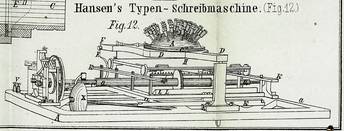
- This is probably one of the writing ball models that was exhibited in Copenhagen in 1872. The illustration above was used in Polytechnisches Journal in an article about the writing ball at the exhibition. Their information was based on an article in the "Engineer" from August 1872. Malling-Hansen worked constantly to improve his writing ball during the 1870's, and the model with the flat carriage replacing the cylinder, was finished some time in 1871, as were the open cylinder-model and the takygraf
Vienna - 1873
In 1873 Malling-Hansen personally travelled to Vienna with his writing ball, to show it to the European public, and he received the First Price medal, called The Vortschritts medal at this exhibition too. The same year he was also honoured with the Austrian Goldmedal, "pro literus et artibus";. According to an article on the website of the Royal Library in Copenhagen, Malling-hansen applied for financial support from official Danish funds to afford to attend the event, but his application was turned down. Instead he was personally invited by the director of the exhibition and was offered to get all his expences covered, including a daily amount as long as he stayed in Vienna. Malling-Hansen was also very proud that his writing ball was placed in the impressing main building of the exhibition, the rotunda. A man who was very well aquainted with the writing ball had a seat in the jury in Vienna, the Danish industrial historian, Camillus Nyrop, who wrote an article about the writing ball in "Illustrated Journal"; (Illustreret Tidende) in 1876. We know with certainty from the reports from the Exhibition that 3 different models of the writing ball were exhibited in Vienna. Exactly which models is uncertain though, but probably one of the cylinder models, with or without the wooden box, the flat model, and the takygraf.
Leeds - 1875
Yorkshire Exhibition, ARTS AND MANUFACTURES, Leeds 1875
Official Catalogue.
No. 19 HOLTEN, SOFUS E., 32 Ludgate Hill, London, E.C.
THE “WRITING BALL”, or ELECTRIC TYPE-WRITING APPARATUS.
An ingenious instrument devised by the Rev. MALLING HANSEN, by
which any one, even the Deaf and Dumb, may write or print with great speed and accuracy.
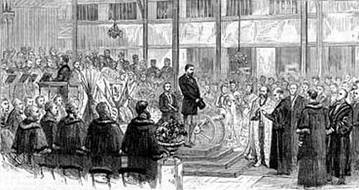
- 22nd May 1875. Two engravings taken from the Illustrated London News commemorating the visit of the Duke of Edinburgh to Leeds. The Duke, Prince Alfred, arrived in Leeds on 13th May 1875 to open the Yorkshire Exhibition of Arts and Manufacturers which was held to raise money for Leeds Mechanics Institute. The left view shows the town clerk, Mr Capel Augustus Curwood, standing towards the right next to the Mayor H.R. Marsden, giving the address to the Duke of Edinburgh who stands on a raised platform in the centre. The Exhibition was held in the Coloured Cloth Hall. The choir and orchestra stands to the left. Behind the Duke is a 6-pounder field gun made by Greenwood and Batley. The lower view shows the ball held in Victoria Hall in the Town Hall later in the evening. The ball was given by the Mayor, Mr Marsden and the Mayoress. In this view, the Duke is in the centre with Mrs Marsden, beginning the first quadrille.

- Visit of the Duke of Edinburgh 1875 to open the Yorkshire Exhibition of Arts and Manufacture. The main purpose of the exhibition was to pay off the debt incurred by the building of the Mechanics Institute. The Duke of Edinburgh travelled by train to Leeds, arriving in time for lunch at Avenue House, the residence of the Mayor, H R Marsden. The Prince then went on to open the exhibition which was held in the Edinburgh Hall which had been specially erected in the central yard of the Coloured Cloth Hall. These two illustrations and the captions originates from www.leodis.net
Richmond & Ripon Chronicle 1875.06.19.
Research, transcription and comments by Jørgen Malling Christensen.
Illustrations and publication be Sverre Avnskog.
The text below is a passage from a long article describing some of the more interesting items exhibited at the Arts and Manufactures Yorkshire Expedition in Leeds in the summer of 1875. The writing ball was exhibited by Malling-Hansen’s agent in London, Sofus Emil Holten, 1836-1885.
A DAY AT THE LEEDS EXHIBITION BY A WORKING MAN.
Amongst the many singular contrivances in this section, there is nothing more so than the writing ball, invented by the Rev. Malling Hansen, of Copenhagen, for the use of the blind. It has since been applied in this country, to writing out, or, more properly speaking, printing messages as read off the Morse or Wheatstone instruments[1].
It presents a very curious appearance, resembling a metal hedgehog bristling with spines. Each one of these spines is a piston, which, upon being pressed by the finger, prints a letter upon the paper below. In fact, by this little instrument, an individual can print from dictation, or from his own reading, as fast as his fingers can play upon the little pistons.
These are not in a straight line but are arranged as to be easily under the hand. It can be worked at the rate of ten letters in a second. The motive power for moving the prepared paper, &c., is a single electromagnet.
[1] JMC: That is: instruments for telegraphy.
Yorkshire Post and Leeds Intelligencer 1875.08.11.
Research and transcription by Jørgen Malling Christensen.
Publication by Sverre Avnskog.
- - - - -
THE YORKSHIRE EXHIBITION.
TELEGRAPHY AND TELEGRAPHIC APPARATUS.
……. Mention should also be made of “The Writing Ball”, an ingenious invention of the Rev. M.Hansen, superintendent of the Royal Deaf and Dumb Institute at Copenhagen, for enabling the blind to write or print matter, either original of from speech or dictation, and to obtain or produce multiple copies of their work; …..
Preston - 1875.
A Writing Ball Exhibited in Preston August 1875.
Research, transcription and comments by Jørgen Malling Christensen.
Illustrations and publication by Sverre Avnskog.
We have previously documented, that Rasmus Malling-Hansen exhibited an electrical model of the writing ball at the Arts and Manufactures Exhibition in Leeds, Yorkshire, England, which ran from May 13 until sametimes in September 1875. The writing ball was presented by Malling-Hansen's agent, Sophus E. Holten.
Evidence has now surfaced about yet another exhibition, where Holten exhibited an electrical version of the writing ball, namely at the Preston Exhibition of Works of Art and Industry. This exhibition opened on August 10, 1875 and was organised at Moor Park, Preston, Lancashire.
The town of Preston was a good choice by Malling-Hansen and Holten: "Preston was a boomtown of the Industrial Revolution, becoming a densely populated engineering centre, with large industrial plantsll (Wikipedia). Also, it was not far away from Leeds, where presumably the same writing ball was exhibited from mid May that year. The distance between Leeds and Preston is approximately 70 kms, and the two important towns were connected by rail.
The information about the writing ball being exhibited in Preston was found in an article in "Preston Heraldl, June 26, 1875, the relevant text transcribed below:
THE PRESTON ART AND INDUSTRIAL EXHIBITION. -
On Wednesday evening the weekly meeting of the General Committee was held at the Town-Hall....... (JMC: The members are presented by name and function)...
The sub-committees then presented their reports, which included the following additional promises: - Natural History and Scientific Committee: An electric writing ball (which will be worked by one of the employees from the Blind Institute) by Mr. S. E. Holten, London.
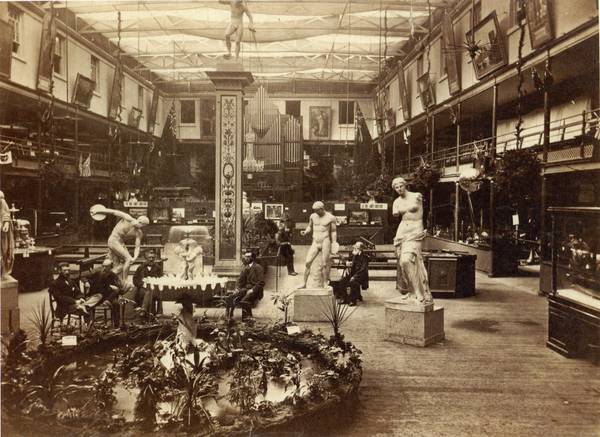
- A picture from the Preston Art and Industrial Exhibition in 1875. Illustration from the internet.
Philadelphia - 1876
From Rasmus Malling-Hansen's great-grand son i USA, Poul Bech, we have received information that RMH participated at the International Exhibition in Philadelphia in 1876. If someone think they have heard the name Bech in connection to RMH before, they are probably right, because one of the daughter's of Malling-Hansen, Zara, 1870-1910, was married to Fritz August Bech, and their son, Erling Bech, emigrated to USA. His descendants are still living in USA.
At the Centennial Exhibition in 1876, Malling-Hansen had two items on display, a writing ball and the takygraf, wich worked by the means of electricity. We have some very few pictures of the takygraf, so it's a fact that it was made in at least one specimen - but what happened to it, and where it may be today, is a great mystery!
As for the writing ball at the exhibition, it is not known wether it was the first tall model, that was patented in 1875, or if it was the flat model with a carriage, patented in USA in 1874, but most likely it was the tall model. I base this on the formulation in the ofiicial catalogue, where it is stated that the takygraf was operated by electricity, and that the writing ball was operated by hand. The tall model without colour ribbon from 1875 was the first model that was operated only by hand - without electricity.

- Malling-Hansen's writing ball was awarded with the gold medal at the 1876 Philadelphia Exhibition. Above is an old engraving that shows what the medal looked like. Oddly enough Malling-Hansen didn't use this medal in his marketing of the writing ball - only the Copenhagen, Vienna and Paris medals. Why, we don't know
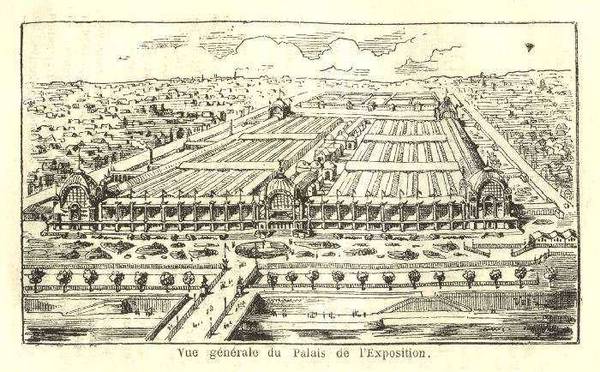
- The main exhibition building at the World Exhibition in Paris in 1878. According to a letter to his brother, Johan Frederik Hansen from the same year, Rasmus Malling-Hansen had 4 models of his writing ball at display at this event, and he won one gold and one silver medal. The gold medal for the writing ball as a typewriter, and a silver medal for the writing ball as an aducational apparatus for blind people
Paris - 1878
Then in 1878 Malling-Hansen attended the World Exhibition in Paris, and for this event he had worked out four models of the writing ball, two of them shown in the information folder of the Danish Section. The writing ball had gone through several important improvements, and now it was equipped with a colour ribbon and did not longer use an electromagnetic battery, and thus the weight and the size were reduced drasticly. Also in Paris he received the First Price medal in gold. At the same exhibition his competitor, the American typewriter inventor Densmore, also exhibited his Sholes&Glidden typewriter produced by the Remington Factory. His typewriter was at this stage very big and heavy, and received the Silver medal in Paris, a fact that Malling-Hansen refers to in some of his letters from this period. It's obvious that he was extremely proud that the experts valued his writing ball higher than the American Remington machine. But as we know, he still lost the commercial competition, as the improved Remington machine only a few years later was sold in a number of probably more than 2500 specimens, while the writing ball produced never exceeded more than a couple of hundreds. According to private letters to his brother, Johan Frederik Hansen, Malling-Hansen exhibited 4 different models in Paris. From the official papers we know that the new tall model with colour ribbon and the small model for paperstrips on a wooden foot were developed for this exhibition. The two other models may have been writing balls with Braille and Moon alphabet, because Malling-Hansen also received a silver medal for the writing ball as an educational apparatus for blind people in Paris.
Rasmus Malling-Hansens forberedelser for deltagelse i Verdensudstillingen i Paris 1878.
Transkribering og kommentarer af Jørgen Malling Christensen.
Vi har fundet den blanket Malling-Hansen brugte i forbindelse med anmeldelsen til den danske Komité for deltagelse i verdensudstillingen i Paris i 1878, hvor han viste fire forskellige skrivekugler og indhøstede stor, positiv opmærksomhed – og desuden adskillige bestillinger fra forskellige lande! Han belønnedes med guldmedalje for skrivekuglen i sin skrivemaskine-form – den smukke og elegant høje model med farvebånd og uden batteri - , og en sølvmedalje for en skrivekugle med braille eller moon-alfabet til brug for blinde. Fra en anden kilde – en avisartikel i Berlingske Tidende fra 17.oktober 1878 – ved vi at tre af skrivekuglerne skrev på almindeligt papir, medens den fjerde skrev på en smal telegrafstrimmel.
Vi har også (se brevsamlingen) et brev fra RMH til hans bror Johan Frederik, dateret 2 juni 1878, i hvilket han fortæller: “Jeg har nu fire Maskiner færdige at gaa til Paris. De ere alle forskjellige. Hr Duch reiser med dem, vistnok paa Onsdag.”
Hr. Duch var en dansk telegrafist, som åbenbart havde to vigtige egenskaber: Han kunne betjene skrivekuglerne; og han kunne forklare deres funktion på flere forskellige sprog. Duch var ansat på det Store Nordiske Telegraph-Selskab og blev velvilligt udlånt – på orlov – fra sin tjeneste for at kunne hjælpe Malling-Hansen med at på betryggende måde transportere skrivekuglerne frem og tilbage og med at demonstrere dem på verdensudstillingen. Denne velvillige, og for RMH sikkert meget vigtige, assistence hænger sammen med at Carl Frederik Tietgen (1829-1901), den tids store industri- og finansmand, havde fået øjnene op for den nytte skrivekuglerne kunne gøre ved telegrafstationerne. Tietgen havde ved et par tilfælde lånt RMH penge – fra mæcenens private tegnebog – for viderudvikling af skrivekuglen for telegrafstrimler. Dette fremgår af de “hemmelige arkiver” Tietgen brugte for visse transaktioner.
I det følgende gengives RMHs anmeldelsesinformation, som er skrevet med hans karakteristiske håndskrift på et stort papirformat. Se også en kopi af den originale blankets to sider.
Blankettens første side:
Tilbagesendes i to enslydende Exemplarer til Komiteens Sekretær, Industriforeningen, Holmens Kanal 12, Kjøbenhavn K.__________________
Verdensudstillingen i Paris 1878.
Undertegnede R. Malling Hansen.
Boende Kgl. Døvstumme-Institut, Ørebro, Kjøbenhavn.
Har afsendt til (Komiteen for Danmarks Deltagelse) direkte til Verdensudstillingen i Paris nedenstaaende Gjenstande:
=====================================================
Gjenstandens L.b. Nr. - Danemarque, Copenhague, R.Malling Hansen (to ord ulæselige), Hr. A. Duch, L’Exposition Internationelle à Paris.
Gjenstandenes Benævnelse - 4 Exemplarer af Skrivekuglen.
Salgspris i Francs - Maa ikke sælges.
Total Værdi for hver Kolli - Ialt Kr. 1500.
Afsendte den 9 Juli 1878
R. Malling Hansen.
Blankettens anden side:
På anden side har RMH tegnet en skitse, som anviser hvorledes de fire maskiner skal fremvises, og han giver desuden detaljerede informationer om alle mål og instruktioner angående placering, sikkerhedsaspekter etc:
NB: Alle Maalene ere fremgaaede af en nøie Overveielse og maatte - om muligt nøie overholdes. R. M-H.
Figur 1: - - -
A er en Glaskasse, der er 9 Tommer høi og 3 Quarter Alen lang og bred, indvendigt Maal. Den maa være til at tage helt bort fra Bordet, naar Operateuren[1] arbeider med Maskinerne; men maa ogsaa paa en eller anden Maade kunne lukkes fast til Bordet, saa at ingen uvedkommende kan tage Kassen af, naar Operateuren er borte. a, a, a, a er 4 Skrivemaskiner[2] , alle indb. forskjellige. –
B er et Bord af sædvanlig Bordhøide (5 Quarter); Pladen er 2 Alen paa den ene Led og 1⅓ Alen paa den anden; den maa være noget Tyk (for at Lyden ikke skal blive for stærk under Skrivningen) og betrukken med grønt eller brunt Klæde.
C er en Stol , helst en let Contoirstol, Dreierstol, eller Rørstol med Sædet i en Høide af 1 Alen 1 Tomme fra Gulvet, altsaa 7 Tommer høiere end almindelig Stolesæde-Høide. –
E,E - - - er den ene Side – mod hvilken den Skrivende vender Ryggen, den maa gjerne være dækket af en Væg eller en Monter; de andre 3 Sider derimod maa yde fri Adgang for Publicums Øine, dog saaledes , at Folk paa ingen Maade maa kunne komme tæt hen til Bordet, omringe dette under Skrivningen, pille ved Maskinerne o.s.v. - Derfor er
D.D - - - et Rækværk, der er 4 Alen langt paa den ene Led og 3 fem sjettedelen Alen paa den anden Led, det er 1 ¼ Alen høit og bestaar af
F,F F - - - Jernstænger, 1¼ Alen lange med et Øie foroven (og i en Afstand af 1 Alen fra hinanden), hvorigjennem kan føres
GG - - - et pænt, farvet Reb.
NB: en Skuffe ønskes anbragt et eller andet Sted i Bordet, dog ikke paa den Side, som Skriveren sidder ved. – Bordet maatte helst staa paa en Forhøining, der er saa stor at Stolen ogsaa kan faa Plads paa den. -
Figur 2: - viser Rækverket set fra Siden : F. Jernstængerne med 1 Alen imellem.
19-6-78 R. Malling Hansen.
[1] JMC: Operateuren var altså den omtalte Hr A. Duch.
[2] JMC: Det er yderst interessant at RMH her bruger ordet ”skrivemaskiner”! Det er en meget tidlig brug af ordet – og langt inden det var gængse sprogbrug i Danmark!
Altona - 1881
Research, transcription, translation and comments by Jørgen Malling Christensen.
Illustrations, comments and publication by Sverre Avnskog.
In Norddeutsche Allgemeine Zeitung from 1881.09.02 it is stated that the writing ball was exhibited in Altona in 1881 taking part in: “Die internationale Ausstellung von Arbeits- und Kraftmaschinen zu Altona” (International Exhibition of workshop machines and power engines), which opened on August 18,1881.
Norddeutsche Allgemeine Zeitung had a reporter present, and his three part article about the exhibition were published on August 19 (evening edition, front page), on August 26 (morning edition, page 5) and on September 2, 1881 (evening edition, page 5). The latter edition is what interests us most, because of the comment on the writing ball being exhibited and demonstrated.
This part of the text is transcribed and translated below:
Wanderungen durch die internationale Ausstellung zu Altona.
Von unserem Spezial-Berichterstatter.
III.
- Zum Schlusse under heutigen Wanderung besichtigen wir noch die gleich am Eingang aufgestellte Schreibkugel von Malling Hansen, welche 8 Zoll im Durchmesser und in 54 Stempeln alle Buchstaben, Zahlen und Unterscheidungszeichen enthällt. Ob sich das Schreiben auf derselben leicht entlernen läßt, vermögen wir nicht zu beurtheilen; jedenfalls handhabten die in der Ausstellung anwesenden Vertreter sowie eine Junge Dame sie mit große Geschicklichkeit, und die Buchstaben kommen deutlich und exakt auf das Papier. Möglich, daß die Schreibkugel unserer gewöhnlichen Schreibfeder einmal wirksame Konkurrenz macht.
In English:
Walking through the international exhibition in Altona.
By our special reporter.
III.
....At the end of our walk tour today we examine Malling Hansen’s writing ball, exhibited right at the entrance, 8 inches wide and with 54 keys containing all letters, digits and punctuation marks. Whether it is easy to learn writing with the machine, we cannot judge; nevertheless, the representatives present at the exhibition used it very skilfully – including a young lady -, and the letters are printed clearly und with precision on the paper. It is possible, that the writing ball, one day will become a real competitor to our ordinary pen.
Copenhagen - 1888
The last exhibition, in which a writing ball was exhibited, was at the Scandianavian Art, Agricultural and Industrial exhibition in Copenhagen in 1888. The mechanic, August Lyngbye, was now in charge of the development of the writing ball, and his mechanical establishment had collected not less than seven writing balls for the event, showing the development of the writing ball from 1870 and up to 1888. The newest model, created by Lyngbye, had a colour ribbon and a paper platen, and was much lower than the well known, tall form. Lyngby recieved the First Price medal for this writing ball, but it was not made in a high number, as Malling-Hansen died only two years later, and all orders were cancelled. According to adverisements from Aug. Lyngby, he could build writing balls with both small and capitol letters, but no such machine is known to exist today...
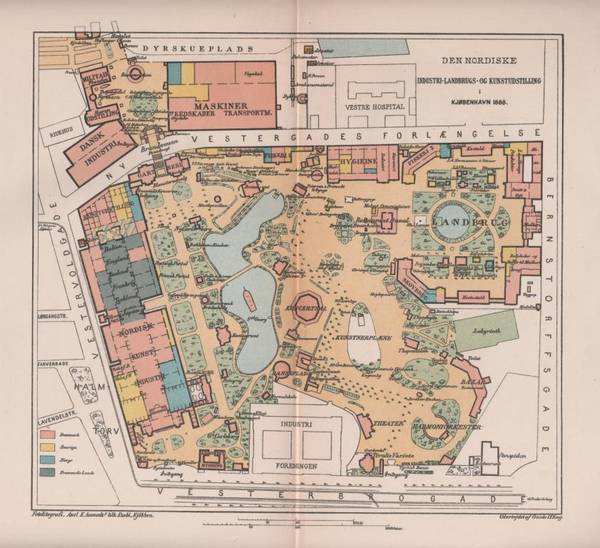
- A map showing the exhibition area at the exhibition in Copenhagen in 1888
Winner of honour - looser of the commercial competition
When comparing the "Type writer" and the "Writing ball", one notices the eyestriking differences between the ways of thinking that lies behind the two inventions. Even though they are both designed to make typed writing, the principles of their functions are miles away from each other.
The Remington 1 is a socalled "upstriker", which means that the letters strike the paper from underneath. The writer can thus not see what he is writing, but has to lift the upper part of the machine to view the writing. The "arm" from the key to the letter is articulated, and to prevent the arms from entangling into each other, Sholes invented the qwerty-keyboard, where the letters that are most frequently used, are placed far away from each other. The writing speed was not a motivation in the placement of the letters on the keys.
The Malling-Hansen writing ball, is based on totally different principles. Compared to the Remington, the pistons are extremely short, and strikes from above, in a radiant angle through the ball and directly on the paper, giving a very stable and punctual writing. It is much smaller, weighing much less, and the whole construction is open, and in principle very simple, but extremely finely crafted. In order to see what he has written, the writer may bend his head and watch underneath the ball. Malling-Hansen arranged the letters on the keys, after a lot of experimenting, in the way that made possiple the fastest writing speed, the most frequently used letter being manipulated by the fastest writing fingers.
In an article in "The Illustrated Paris Universal Exhibition" from 1878, the author compares the Malling-Hansen writing ball and the Remington typewriter like this: " In the year 1875, a quick writing apparatus, designed by Mr. L. Sholes in America, manufactured by Mr. Remington, was introduced in London. This machine was superior to the Malling-Hansen writing apparatus; but the writing ball in its present form far excels the Remington machine. It secures greater rapidity, and its writing is clearer and more exact than that of the American instrument. The Danish apparatus has more keys, is much less complicated, built with greater precision, more solid, and much smaller and lighter that the Remington, and, moreover, is cheaper."
The patent rights and the right to produce in the Remington name, were soon sold to others, but Densmore's brother developed another, very similar typewriter, The Densmore, which was made in several versions.
Malling-Hansen seems to have more and more lost the interest in working further with his invention. In the 1880's his mind was occupied by his scientific discoveries of the growth of children in periods. The further development of the writing ball was left to the mechanic, August Lyngbye, who designed a new model which was displayed in Copenhagen in 1888.
Maybe Malling-Hansen in his mind felt that he could not win? He had very few supporters - and all by himself had taken care of the production, the advertising and the sale. I have the suspicion that Malling-Hansen at a certain point got worn out - and needed to let his mind go on to other projects. But his daughet, Johanne Agerskov tells that he had great faith in August Lyngbye's model, and before his dead Malling-hansen placed an order for 100 writing balls at his establishment. But after his sudden and tragic death in 1890, the order was cancelled, and no more writing balls were produced.
If the writing ball already at this point was totally outconquered be the American typewriters we really don't know. The first Remington-machine was supposedly sold in 5000 specimens during the years 1873-1877, but many of the numbers from the factories can not be trusted 100%, they often exaggerated to make their machine more attractive. Mure trustable numbers kan be found in other, more reliable sources, and 1560 machines from 1873 until 1882/83 is a more realistic figure.
Oslo 10.12.06
Sverre Avnskog


